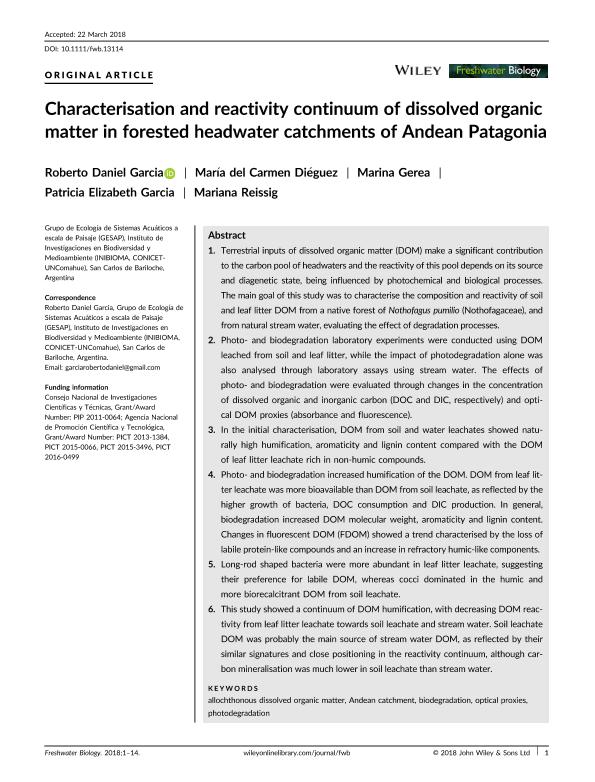Mostrar el registro sencillo del ítem
dc.contributor.author
García, Roberto Daniel

dc.contributor.author
Dieguez, Maria del Carmen

dc.contributor.author
Gerea, Marina

dc.contributor.author
Garcia, Patricia Elizabeth

dc.contributor.author
Reissig, Mariana

dc.date.available
2020-08-28T11:18:48Z
dc.date.issued
2018-09
dc.identifier.citation
García, Roberto Daniel; Dieguez, Maria del Carmen; Gerea, Marina; Garcia, Patricia Elizabeth; Reissig, Mariana; Characterisation and reactivity continuum of dissolved organic matter in forested headwater catchments of Andean Patagonia; Wiley; Freshwater Biology (print); 63; 9; 9-2018; 1049-1062
dc.identifier.issn
0046-5070
dc.identifier.uri
http://hdl.handle.net/11336/112602
dc.description.abstract
Terrestrial inputs of dissolved organic matter (DOM) make a significant contribution to the carbon pool of headwaters and the reactivity of this pool depends on its source and diagenetic state, being influenced by photochemical and biological processes. The main goal of this study was to characterise the composition and reactivity of soil and leaf litter DOM from a native forest of Nothofagus pumilio (Nothofagaceae), and from natural stream water, evaluating the effect of degradation processes. Photo- and biodegradation laboratory experiments were conducted using DOM leached from soil and leaf litter, while the impact of photodegradation alone was also analysed through laboratory assays using stream water. The effects of photo- and biodegradation were evaluated through changes in the concentration of dissolved organic and inorganic carbon (DOC and DIC, respectively) and optical DOM proxies (absorbance and fluorescence). In the initial characterisation, DOM from soil and water leachates showed naturally high humification, aromaticity and lignin content compared with the DOM of leaf litter leachate rich in non-humic compounds. Photo- and biodegradation increased humification of the DOM. DOM from leaf litter leachate was more bioavailable than DOM from soil leachate, as reflected by the higher growth of bacteria, DOC consumption and DIC production. In general, biodegradation increased DOM molecular weight, aromaticity and lignin content. Changes in fluorescent DOM (FDOM) showed a trend characterised by the loss of labile protein-like compounds and an increase in refractory humic-like components. Long-rod shaped bacteria were more abundant in leaf litter leachate, suggesting their preference for labile DOM, whereas cocci dominated in the humic and more biorecalcitrant DOM from soil leachate. This study showed a continuum of DOM humification, with decreasing DOM reactivity from leaf litter leachate towards soil leachate and stream water. Soil leachate DOM was probably the main source of stream water DOM, as reflected by their similar signatures and close positioning in the reactivity continuum, although carbon mineralisation was much lower in soil leachate than stream water.
dc.format
application/pdf
dc.language.iso
eng
dc.publisher
Wiley

dc.rights
info:eu-repo/semantics/openAccess
dc.rights.uri
https://creativecommons.org/licenses/by-nc-sa/2.5/ar/
dc.subject
ALLOCHTHONOUS DISSOLVED ORGANIC MATTER
dc.subject
ANDEAN CATCHMENT
dc.subject
BIODEGRADATION
dc.subject
OPTICAL PROXIES
dc.subject
PHOTODEGRADATION
dc.subject.classification
Otras Ciencias de la Tierra y relacionadas con el Medio Ambiente

dc.subject.classification
Ciencias de la Tierra y relacionadas con el Medio Ambiente

dc.subject.classification
CIENCIAS NATURALES Y EXACTAS

dc.title
Characterisation and reactivity continuum of dissolved organic matter in forested headwater catchments of Andean Patagonia
dc.type
info:eu-repo/semantics/article
dc.type
info:ar-repo/semantics/artículo
dc.type
info:eu-repo/semantics/publishedVersion
dc.date.updated
2019-10-10T13:46:52Z
dc.identifier.eissn
1365-2427
dc.journal.volume
63
dc.journal.number
9
dc.journal.pagination
1049-1062
dc.journal.pais
Estados Unidos

dc.journal.ciudad
Hoboken
dc.description.fil
Fil: García, Roberto Daniel. Consejo Nacional de Investigaciones Científicas y Técnicas. Centro Científico Tecnológico Conicet - Patagonia Norte. Instituto de Investigaciones en Biodiversidad y Medioambiente. Universidad Nacional del Comahue. Centro Regional Universidad Bariloche. Instituto de Investigaciones en Biodiversidad y Medioambiente; Argentina
dc.description.fil
Fil: Dieguez, Maria del Carmen. Consejo Nacional de Investigaciones Científicas y Técnicas. Centro Científico Tecnológico Conicet - Patagonia Norte. Instituto de Investigaciones en Biodiversidad y Medioambiente. Universidad Nacional del Comahue. Centro Regional Universidad Bariloche. Instituto de Investigaciones en Biodiversidad y Medioambiente; Argentina
dc.description.fil
Fil: Gerea, Marina. Consejo Nacional de Investigaciones Científicas y Técnicas. Centro Científico Tecnológico Conicet - Patagonia Norte. Instituto de Investigaciones en Biodiversidad y Medioambiente. Universidad Nacional del Comahue. Centro Regional Universidad Bariloche. Instituto de Investigaciones en Biodiversidad y Medioambiente; Argentina
dc.description.fil
Fil: Garcia, Patricia Elizabeth. Consejo Nacional de Investigaciones Científicas y Técnicas. Centro Científico Tecnológico Conicet - Patagonia Norte. Instituto de Investigaciones en Biodiversidad y Medioambiente. Universidad Nacional del Comahue. Centro Regional Universidad Bariloche. Instituto de Investigaciones en Biodiversidad y Medioambiente; Argentina
dc.description.fil
Fil: Reissig, Mariana. Consejo Nacional de Investigaciones Científicas y Técnicas. Centro Científico Tecnológico Conicet - Patagonia Norte. Instituto de Investigaciones en Biodiversidad y Medioambiente. Universidad Nacional del Comahue. Centro Regional Universidad Bariloche. Instituto de Investigaciones en Biodiversidad y Medioambiente; Argentina
dc.journal.title
Freshwater Biology (print)

dc.relation.alternativeid
info:eu-repo/semantics/altIdentifier/url/https://onlinelibrary.wiley.com/doi/abs/10.1111/fwb.13114
dc.relation.alternativeid
info:eu-repo/semantics/altIdentifier/doi/https://doi.org/10.1111/fwb.13114
Archivos asociados
